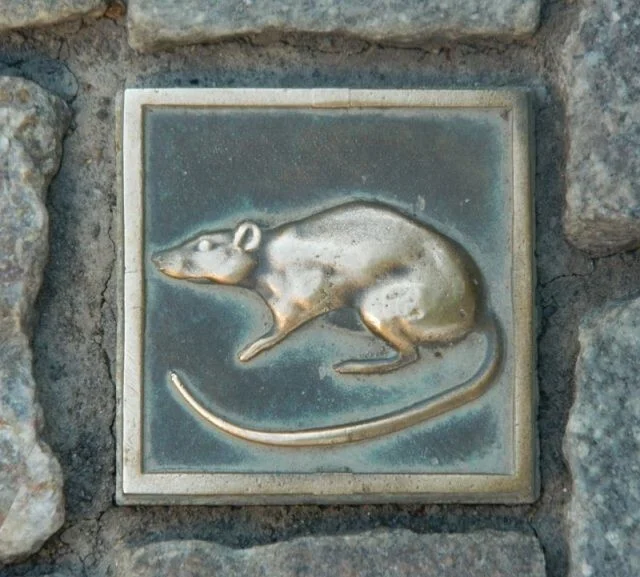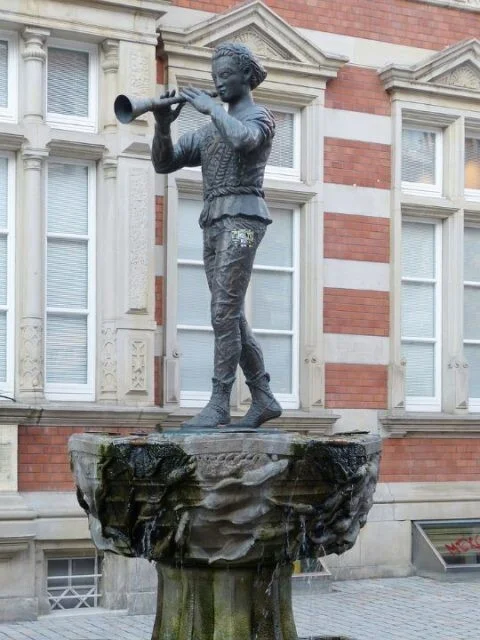How the Day of the Pied Piper of Hamelin is celebrated in Hamelin (8 photos)
For residents of the German town of Hameln, the legend of the mysterious Pied Piper is not just an old fairy tale. The legend has become so firmly entrenched in their lives that every year on June 26, Pied Piper Day is celebrated here, and the story itself is included in the UNESCO cultural heritage list. 
About the fairy tale and its many endings
Legend has it that rats took over the city at the end of the 13th century. Local residents tried everything to get rid of the rodent infestation, but to no avail. Then a mysterious man in motley multi-colored clothes entered the city and promised to save the townspeople from the scourge for a large reward. The locals agreed, the Pied Piper played the flute, and all the rats in the city, captivated by the melody, followed him straight into the Weser River, where they drowned.
However, the city magistrate told the Pied Piper that he would not pay him the full amount, and according to another version, he refused to pay him at all. The Pied Piper left the city, but vowed revenge. He returned a few days later, on the feast of Saints John and Paul (June 24), and this time all the children in the city flocked to the call of his magic flute. 
Their fate differs in different versions of the story. Some claim that they, like the rats, drowned in the Weser River, while others say that the Pied Piper took the children towards the mountain and no one ever saw them again. According to another version, the Pied Piper returned the children when he was paid - either the original amount in full, or many times more. In almost all versions of the legend, several children survived because they could not hear the music.
Fact or fiction?
As with all legends, there may be some truth to the tale of the Pied Piper.
In the earliest archives of the city of Hamelin there is an entry that dates back to 1384: “100 years have passed since the day our children left us.” Texts from the 14th to 17th centuries also mention that a stained glass window illustrating the tragedy was installed in the church around 1300. Unfortunately, the stained glass window was destroyed in 1660, so it is impossible to say exactly which version of the legend it depicted. 
Hamelin also has a house called Rattenfangerhaus (Ratcatcher's House), built in 1602 or 1603. It got its name from a tablet found in it with an inscription that can be roughly translated as: “In 1284, on the day of Saints John and Paul, June 26, a piper in multi-colored robes led 130 children born in Hameln to Golgotha.”
About a real tragedy
It is obvious that some kind of tragedy did occur, but how close is the legend to real events? According to some studies, rats began to appear in new versions of the legend only in 1559, and over the years, researchers have tried to figure out what really happened in Hamelin.
One theory is that the children were victims of dance mania, a mental epidemic that arose in the 13th century. There is a known case in which in 1237 in central Germany a group of children, obsessed with this mania, literally danced from one city to another - indeed, very similar to the legend of the Pied Piper. 
Many historians believe that the children left the city as a result of the emigration movement. Historian Ursula Sautter notes that in some parts of Germany, bishops and dukes sent "locators" - recruiters who persuaded young people to move to parts of Eastern Europe that needed new settlers after the war. This theory is supported by the fact that surnames characteristic of Hamelin are found in the areas of Prignitz and Uckermack in Germany.
Hamelin today
Today, Hamelin has a population of about 56,000 people, and the legend of the Pied Piper is still revered in the city. 
The legend is reflected, for example, in the architecture: the “Pied Piper’s House” turned into a restaurant with appropriate decoration. Two fountains were also installed in honor of the Pied Piper: one in 1975, depicting children following the Pied Piper, and the second, with rats, on June 23, 2001. The city also has "Rat Stones" - small bronze signs on the city streets that point tourists to the places featured in the legend. 
The lost stained glass window was replaced with another as part of the celebration of the 700th anniversary of the legend. There is also a clock in the city with small figures that are shown at certain times: at 1:05, 3:35 and 5:35 the Pied Piper appears from the clock, leading first the rats and then the children. At 9:35 the “Song of the Pied Piper” plays, and at 11:35 (according to legend, it was then that the Pied Piper entered the city) “Song of the Weser River”. 
For tourists who want to dive deeper into the history of the legend, the Hamelin Museum features the world's largest collection dedicated to the Pied Piper, as well as a mechanical theater that plays out the plot of the legend.
In the summer, a free performance is performed in the city center every Sunday; It also offers various excursions so that tourists can retrace the steps of the Pied Piper and the Lost Children. However, on one street, Bungelosenstrasse ("street without drums"), playing music or dancing is prohibited, as it is believed that this is where the children were last seen.
In the Year of the Rat, the Hameln360AR application was created in Hamiln. Users of the application get access to a huge amount of information about Hamiln, and tourists can try on the role of the Pied Piper and look for virtual rats on the streets of the city, receiving discounts and bonuses as a reward. 
The musical Rats, which premiered at EXPO 2000, is now shown in the city every year. The screenplay is based on Robert Browning's version of the story, with music and lyrics by Nigel Hess.
In addition to landmarks, UNESCO also protects “intangible cultural heritage,” including oral traditions, performing arts and celebrations, deeming such practices “an important factor in preserving cultural diversity in the face of increasing globalization.” After residents of Hamelin made a video detailing the importance of the traditions associated with the Pied Piper, The Legend of the Pied Piper was added to Germany's list of intangible cultural heritage in 2014.
